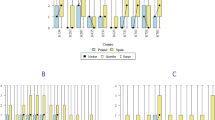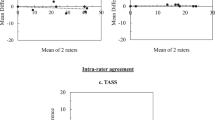Abstract
Objective:
To validate the International Classification of Functioning, Disability and Health (ICF) core sets for individuals with spinal cord injury (SCI) in the early post-acute and long-term context from the perspective of occupational therapists (OTs).
Setting:
International
Methods:
OTs experienced in the treatment in SCI were asked about problems, resources and aspects of the environment treated by them, in a three-round electronic mail survey using the Delphi technique. Responses were linked to the ICF by two researchers; kappa coefficient was calculated as statistical measure of agreement.
Results:
In total, 67 experts from 27 countries named 2586 different concepts. For the early post-acute context, 223 concepts were linked to ICF categories. Three ICF categories from the component body function, three ICF categories from the component body structures and five ICF categories from the component activities and participation were not represented in the ICF core set for the early post-acute context with an expert agreement of more than 75%. For the long-term context, 205 concepts were linked to ICF categories. Two ICF categories from the component body function, four ICF categories from the component body structures and two ICF categories from the component activities and participation were not represented in the ICF core set with an expert agreement of more than 75%.
Conclusion:
OTs addressed a vast variety of problems that they take care of in their interventions in persons with SCI. The Comprehensive ICF core sets covered a high percentage of these problems. Further research is necessary on a few aspects that are not included in the ICF core sets for SCI.
Similar content being viewed by others
Log in or create a free account to read this content
Gain free access to this article, as well as selected content from this journal and more on nature.com
or
References
Noreau L, Fougeyrollas P, Post M, Asano M . Participation after spinal cord injury: the evolution of conceptualization and measurement. J Neurol Phys Ther 2005; 29: 147–156.
WFOT. About Occupational Therapy http://www.wfot.org/office_files/ABOUT%20OCCUPATIONAL%20THERAPY%282%29 pdf (accessed 16 March 2010).
World Health Organization. International Classification of Functioning, Disability and Health: ICF. WHO: Geneva, 2001.
Kirchberger I, Cieza A, Biering-Sørensen F, Baumberger M, Charlifue S, Post MW et al. ICF core sets for individuals with spinal cord injury in the early post-acute context. Spinal Cord 2010; 48: 297–304.
Cieza A, Kirchberger I, Biering-Sørensen F, Baumberger M, Charlifue S, Post MW et al. ICF core sets for individuals with spinal cord injury in the long-term context. Spinal Cord 2010; 48: 305–312.
Sharkey SB, Sharples AY . An approach to consensus building using the Delphi technique: developing a learning resource in mental health. Nurse Educ Today 2001; 21: 398–408.
Cieza A, Geyh S, Chatterji S, Kostanjsek N, Ustün B, Stucki G . ICF linking rules: an update based on lessons learned. J Rehabil Med 2005; 37: 212–218.
Zoski K, Jurs S . Priority determination in surveys. An application of the Scree-test. Eval Rev 1990; 14: 214–219.
Vierkant RA . SAS Macro for Calculating Bootstrapped Confidence Intervals about a Kappa Coefficient 2004. http://www2.sas.com/proceedings/sugi22/STATS/PAPER295.PDF. (accessed 21.2.2010).
Kirchberger I, Cieza A, Stucki G . Validation of the comprehensive ICF core set for rheumatoid arthritis: The perspective of psychologists. Psychol Health 2008; 23: 639–659.
Lemberg I, Kirchberger I, Stucki G, Cieza A . The ICF core set for stroke from the perspective of physicians: a worldwide validation study using the Delphi technique. Eur J Phys Rehabil Med 2010; 46: 377–388.
Donaghy M, Nichol M, Davidson K (eds). Introduction. In: Cognitive Behavioural Interventions in Physiotherapy and Occupational Therapy, 1st edn. Butterworth Heinemann Elsevier: Edinburgh. 2008.
Elliott TR, Godshall FJ, Herrick SM, Witty TE . Problem-solving appraisal and psychological adjustment following spinal cord injury. Cognit Ther Res 1991; 15: 387–398.
Watanabe T . The role of therapy in spasticity management. Am J Phys Med Rehabil 2004; 83 (suppl): S45–S49.
Ozelie R, Sipple C, Foy T, Cantoni K, Kellogg K, Lookingbill J et al. Classification of SCI rehabilitation treatments SCI rehab project series: The occupational therapy taxonomy. J Spinal Cord Med 2009; 32: 283–297.
Goldstein B . Musculoskeletal conditions after spinal cord injury. Phys Med Rehabil Clin N Am 2000; 11: 91–108.
National Office of OT Australia (Occupational Therapy Association of Australia. Australian Competency Standards for Entry-Level Occupational Therapists, OT Australia National 1994 Fitzroy Victoria 3065 www.ausot.com.au. (accessed 21.3.2010).
Sinnott AK, Brander P, Siegert RJ, Alastair G, Rothwell AG, De Jong G . Life impacts following reconstructive hand surgery for tetraplegia. Top Spinal Cord Inj Rehabil 2009; 15: 90–97.
National Board for Certification in Occupational Therapy, Inc. A practice analysis study of entry–level occupational therapists registered and certified occupational therapy assistant practice. OTJR: Occupation, Participation and Health 2004; 24 Supplement.
Samuelson K, Wressle E . User satisfaction with mobility assistive devices. Disabil Rehabil 2008; 30: 551–558.
Söderback I, Söderström M, Schälander E . Horticultural therapy: the ‘healing garden’ and gardening in rehabilitation measures at Danderyd Hospital Rehabilitation Clinic, Sweden. Pediatr Rehabil 2004; 7: 245–260.
Chau L, Hegedus L, Praamsma M, Smith K, Tsukada M, Yoshida K et al. Women living with a spinal cord injury: perceptions about their changed bodies. Qual Health Res 2008; 18: 209–221.
Bassett RL, Ginis KM, Buchholz AC . A pilot study examining correlates of body image among women living with SCI. Spinal Cord 2009; 47: 496–498.
Kielhofner G . Model of Human Occupation—Theory and application 3rd Edition 2002. Lippincott Williams and Wilkins: Maryland.
Law M, Stanton S, Polatajko H, Baptiste S, Thompson- Franson T, Kramer C et al. 1997 Enabling occupation: an occupational therapy perspective. CAOT Publications: Ottawa.
Chapparo C, Ranka J (Eds) Occupational Performance Model (Australia) http://www.occupationalperformance.com/ (accessed 10 10 2010).
Acknowledgements
This project was funded by Swiss Paraplegic Research, Nottwil, Switzerland. We like to thank the participants in the Delphi survey for their valuable contribution and their time in responding to the demanding questionnaires: Helena Aagaard, Meenakshi Batra, Vijay Batra, Aileen Bergström, Susanne Berner Nielson, Sarah Bogner, Alison Camp, Amanda Carr, Cathy Cooper, Tu Dang Van, Allie Di Marco, Elena Donoso-Brown, Brian Dudgeon, Kimberly Eberhard, Monika Edenhofer, Bettina Enders, Lydia Engelbrecht, Joaquim Faias, Valeria Finarelli, Henrica Fransen-Jaïbi, Sigrun Gardarsdottir, Mireille Goy, Hanne Gregersen, Theresa Gregorio-Torres, Karen Hammell, Cindy Hartley, Martha Horn, Iqbal Hossain, Gera Hulting, Mary Hutchison, Yuh Jang, Raimonda Kavaliauskaitë, Sabine Kerlin, Juliane Kirsch, Zdenko Koscak, Ruth Krahl, Mirijana Kucina, Lene Laier, Laleh Lajevardi, Anne Marie Langan, Rafferty Laredo, Emma Linley, Jana Löhr, Carola Lösel, Caroline Lovey, Angelika Lusser-Gantzer, Alison Mannion, Hui-Fen Mao, Cynthia Nead, Clare Nixon, Soo Oh, Shangdar Maring Ronglo, Vardi Rubin, Claudia Rudhe, Annelie Schedin Leiulfsrud, Ellen Severe, Narges Shafaroudi, Ulla Stoll, Narumon Sumin, Dorinda Taylor, Laura Valsecchi, Michelle Verdonck, Molly Verrier, Johanna Wangdell, Eric Weerts, Wachiraporn Wittayanin, Verena Zappe, Stephanie Zuk. The authors also thank Cristina Bostan from the ICF Research Branch in Munich for her contribution to calculate the kappa coefficient and Anita Henniger for her most helpful support regarding the linking process.
Author information
Authors and Affiliations
Corresponding author
Ethics declarations
Competing interests
The authors declare no conflict of interest.
Rights and permissions
About this article
Cite this article
Herrmann, K., Kirchberger, I., Stucki, G. et al. The comprehensive ICF core sets for spinal cord injury from the perspective of occupational therapists: a worldwide validation study using the Delphi technique. Spinal Cord 49, 600–613 (2011). https://doi.org/10.1038/sc.2010.168
Received:
Revised:
Accepted:
Published:
Issue date:
DOI: https://doi.org/10.1038/sc.2010.168
Keywords
This article is cited by
-
Content comparison of the Spinal Cord Injury Model System Database to the ICF Generic Sets and Core Sets for spinal cord injury
Spinal Cord (2019)
-
Challenges and potential improvements in the admission process of patients with spinal cord injury in a specialized rehabilitation clinic – an interview based qualitative study of an interdisciplinary team
BMC Health Services Research (2017)
-
Rehabilitation goals of people with spinal cord injuries can be classified against the International Classification of Functioning, Disability and Health Core Set for spinal cord injuries
Spinal Cord (2016)
-
Impact of joint contractures on functioning and social participation in older individuals – development of a standard set (JointConFunctionSet): study protocol
BMC Geriatrics (2013)



